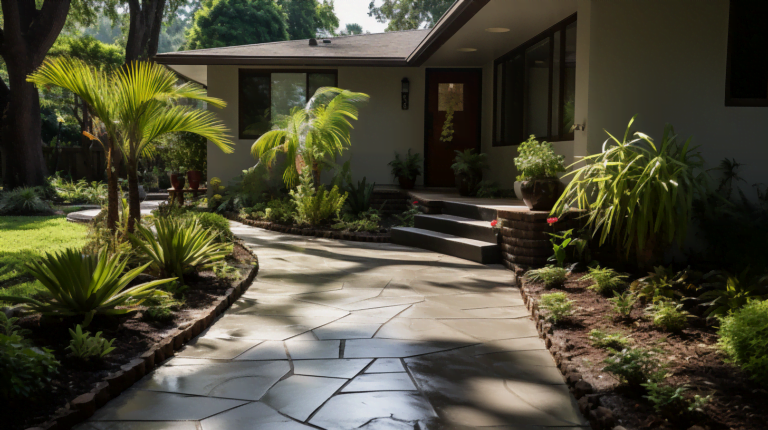The Magic of Concrete Leveling: A Game Changer for Homeowners
The Magic of Concrete Leveling: A Game Changer for Homeowners
Don’t Crack Under Pressure: Conquering Uneven Concrete with Leveling Techniques
Concrete, the ubiquitous hero of the modern building world, stands strong through bustling cities and serene suburbs. Yet, even this mighty material isn’t impervious to the passage of time and the relentless whispers of Mother Nature. Sunken driveways, uneven walkways, and patios tilting like tipsy dancers – these are all familiar woes for homeowners. But fear not, for a revolution is underway in the realm of concrete, and its name is leveling.
Gone are the days of resigned sighs and hefty budgets when faced with cracked and uneven slabs. Concrete leveling has emerged as a game-changer, restoring not just the pristine aesthetics of your property but also its safety and structural integrity.
So, what exactly is the culprit behind those dips and bumps? The unseen villain beneath your feet is the ever-shifting soil. Time, erosion, and natural processes like water movement and tree root growth conspire to undermine the once-solid ground beneath your concrete slabs, causing them to sink and tilt. These uneven surfaces are more than just eyesores; they pose tripping hazards, accessibility challenges, and potential drainage issues.
Traditionally, tackling such woes meant a brutal encounter with sledgehammers and jackhammers – a messy, expensive, and disruptive ordeal. Ripping out and replacing concrete was the only option, leaving homeowners with hefty bills and lengthy construction woes.
But now, breathe a sigh of relief. Enter the realm of concrete leveling, a knight in shining armor ready to vanquish your uneven terrain. This innovative technique offers a smarter, faster, and more cost-effective solution to your concrete woes.
Among the most popular heroes in the leveling brigade is foam injection. Imagine, instead of the symphony of demolition, a tiny team of silent warriors. Small, strategically placed holes are drilled into the sunken slab, and a high-tech polyurethane foam is injected beneath. This magical potion, lighter than air yet mighty in its strength, expands gently, pushing the slab back up to its rightful position. As the foam sets, the concrete surface magically levels out, leaving you with a smooth, restored expanse like a magician’s sleight of hand.
And the best part? This isn’t just a flash-in-the-pan fix. The injected foam dries into a durable, permanent material, providing long-lasting support. Plus, its lightweight nature minimizes stress on your home’s foundation, unlike the heavy burden of traditional concrete replacements.
But the benefits of concrete leveling extend beyond mere functionality. This technique is the epitome of efficiency, causing minimal disruption to your daily life. No more dust clouds, deafening noise, or lengthy construction zones. The process is swift, clean, and often completed within a single day, allowing you to reclaim your driveway, patio, or walkway almost immediately.
Concrete leveling has truly transformed the landscape of property maintenance. It’s a testament to human ingenuity, offering a solution that not only fixes damage but also enhances the value and enjoyment of your home. So, the next time your concrete whispers tales of wear and tear, don’t succumb to the heavy sighs of the past. Choose the path of innovation, the path of leveling. It’s the perfect blend of practicality, aesthetics, and convenience – a win-win for your property and your peace of mind.
Remember, your concrete doesn’t have to crack under pressure. Stand tall, stand level, and embrace the revolution of concrete leveling. Your home, and your sanity, will thank you for it. Because there is nothing like the feel of solid concrete inder your feet.
Concrete is a versatile and widely used construction material composed of a binder, typically cement, mixed with aggregate, usually sand and gravel, and water. When the mixture hardens, it forms a strong and durable solid that can be molded into various shapes and used for a wide variety of purposes.
Here’s a breakdown of the key components:
- Binder: This acts as the glue that holds the aggregate together. The most common binder is Portland cement, which reacts chemically with water to form a hard, rock-like substance.Portland cement powder
- Aggregate: This makes up the bulk of the concrete and provides strength and stability. It typically consists of coarse materials like gravel and crushed rock, and finer materials like sand.Concrete aggregate gravel and sand
- Water: This activates the cement and allows the mixture to be workable and moldable. The amount of water used is crucial for the final strength and quality of the concrete.
Once mixed, the concrete goes through a process called hydration. This involves a chemical reaction between the cement and water that causes the mixture to harden and gain strength over time. The final product is a strong, durable material that can withstand significant compression, tension, and shear forces.
Here are some of the key properties of concrete:
- Strength: Concrete is one of the strongest building materials available, making it ideal for structural applications like foundations, walls, and floors.
- Durability: Concrete is resistant to weathering, fire, and pests, making it a long-lasting and low-maintenance material.
- Versatility: Concrete can be molded into various shapes and forms, making it suitable for a wide range of applications.
- Affordability: Concrete is a relatively inexpensive material compared to other building materials, making it a cost-effective choice for many projects.
Concrete is used in a vast array of applications, including:
- Buildings: Foundations, walls, floors, slabs, and other structural elements.
- Infrastructure: Roads, bridges, dams, tunnels, and other infrastructure projects.
- Precast products: Concrete blocks, pavers, pipes, and other prefabricated elements.
- Decorative elements: Statues, fountains, planters, and other decorative features.
Overall, concrete is a valuable construction material that offers a combination of strength, durability, versatility, and affordability. Its widespread use has made it a cornerstone of modern construction and infrastructure development.

